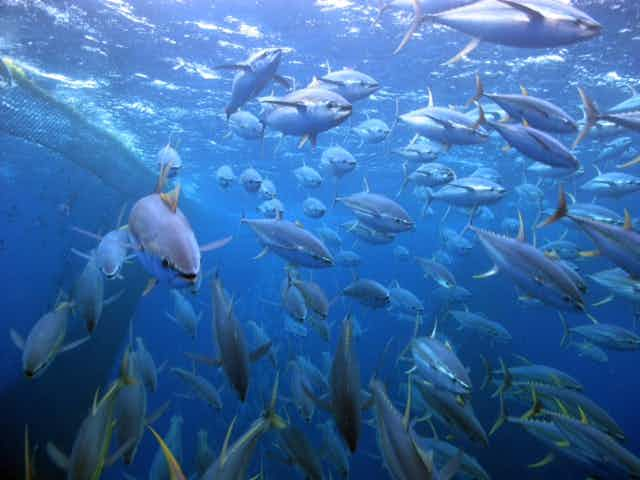Tuna are vital to the ecology and economy of the Pacific, and maintaining their stocks at a sustainable level exercises the minds of thousands of scientists, bureaucrats, fishers, consumers and conservationists. But just how do you go about counting such a wide-ranging fish?
The Western and Central Pacific Ocean supports the world’s biggest tuna fishery with a catch value of over $5 billion. Tuna are important to the economies of the 22 island countries and territories of the Pacific.
Local fishing fleets catch around 30% of the tuna harvested in their exclusive economic zones. The remaining 70% and most of the catch from the high seas is taken by international fleets operating under licenses issued by many of the Pacific countries. The fees these licenses generate are a major source of government revenue. The tuna fishery, particularly processing for export, also creates jobs in a region where unemployment is a hot political issue.
The importance of the tuna fisheries means questions about sustainability are never far from the agenda. What is a “sustainable” catch? What capacity do tuna populations have to renew their numbers? How will tuna react to the warming and acidification of the Pacific?
Ensuring a sustainable catch
The Secretariat of the Pacific Community (SPC) (an internationally-funded research group headquartered in New Caledonia) has responsibility for providing advice on sustainability.
With 22 Pacific Island country and territory members, SPC provides evidence-based scientific advice to Pacific countries on matters ranging from health, land resources and economic development, to fisheries and aquaculture. It’s like a mini-CSIRO for the Pacific. Australia is a member and major donor.
Estimating tuna populations in the Western Central Pacific Ocean is a challenge. Tuna are always on the move, driven by ocean currents, changes in the availability of their prey and other variable processes. They are continuously being born, growing and dying of natural causes in ways that are not well understood.
Tuna are caught by fishing fleets that record and report their catches with varying degrees of accuracy. Sampling is limited to a tiny fraction of this commercial catch, and is often not representative of the tuna population at large.
Not only must the numbers and weight of each species be estimated, but these values then have to be compared with the population size that would produce the maximum yield into the future.
SPC’s tool over the last decade is a computer model called MULTIFAN-CL. It integrates information from three main sources.
The first is length/frequency data gained by counting and measuring a sample of the fish caught by commercial vessels. From this it is possible to estimate the relative numbers of fish of different ages in different areas of the Pacific, and to understand recruitment and mortality in tuna populations.
The second is the relationship between catch and fishing effort (for example, the number of days spent fishing) using log sheets that commercial vessels are required to complete. As the number of fish in the sea is reduced, they become more sparsely distributed and an average fishing trip will produce fewer fish. Knowing this relationship helps track changes in the size of the fish population.
The third source of information comes from tagging programs, where tuna are caught, marked with small plastic numbered tags and released. When tagged fish are re-caught, estimations can be made of fish populations.
Lacking accuracy
In theory it is all very logical, but in practice things are more complicated. Most of the problems revolve around the quality of data.
Length measurements are mainly collected on fishing boats in a busy and dangerous environment where everyone apart from the observer wants to get the fish into the freezer as quickly as possible. As a compromise between speed and accuracy, observers grab five fish from each batch scooped out of the net. Unfortunately, analysis shows they tend to grab medium sized fish not representative of the catch.
Log sheets may not be completed because fishers fear higher charges may be levied if they record larger catches. And the main issue with tagging programs is that they depend on tags being recognised and returned, which is not always the case.
MULTIFAN-CL can handle a huge number of variables and carries out millions of computations to provide the solutions that best fit the data. These numerical results can be provided with statistical confidence limits – measures of the variability of the data - but if the input data is wrong, the results will be too.
So how good are the assessments? Can we be really sure that bigeye tuna are subject to overfishing and the other three species - albacore, yellowfin and skipjack - are not?
Last year bigeye stock assessment (perhaps the most challenging of the four) was reviewed by a team of three independent experts. Their headline conclusion was that the assessment “is based on state-of-the art methods and is analytically very thorough”; but they also made 27 recommendations for improvements.
These mainly concerned improving data inputs and testing alternative interpretations, and will form the basis of SPC’s work before the next assessment in 2014.
So the assessments are certainly the best available at the moment, but there is a continuous process of making them better, and this may result in changes to SPC’s conclusions about the status of the different tuna stocks. It’s a vital process for Pacific nations - livelihoods depend on it.
This article was co-authored by Mike Batty, who is head of the Secretariat of Pacific Community’s Fisheries, Aquaculture and Marine Ecosystem Division.

